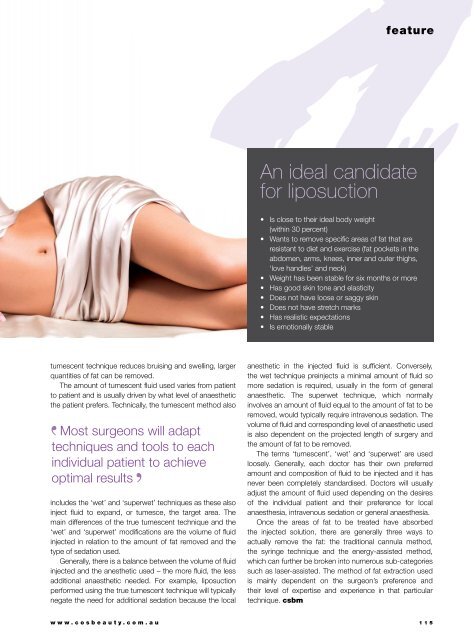Cosmetic Surgery and Beauty Magazine #64
Cosmetic Surgery & Beauty Magazine is the definitive guide to the aesthetic medicine industry for anyone considering a treatment therapy or surgical procedure. This quality quarterly publication contains comprehensive information about practitioners, equipment, techniques, processes and options, presented clearly and completely. The strong emphasis on input by industry professionals provides profiles of the practitioners and understanding of their approach to each procedure, enabling readers to make informed choices in their initial approaches to deciding what will best suit their needs. Hundreds of untouched before-and-after photographs provided by the practitioners themselves graphically illustrate both treatable conditions and the results that can be obtained. Cosmetic Surgery & Beauty Magazine is essential reading for anyone wishing to inform themselves about the options available in aesthetic medicine in Australia.
Cosmetic Surgery & Beauty Magazine is the definitive guide to the aesthetic medicine industry for anyone considering a treatment therapy or surgical procedure. This quality quarterly publication contains comprehensive information about practitioners, equipment, techniques, processes and options, presented clearly and completely. The strong emphasis on input by industry professionals provides profiles of the practitioners and understanding of their approach to each procedure, enabling readers to make informed choices in their initial approaches to deciding what will best suit their needs. Hundreds of untouched before-and-after photographs provided by the practitioners themselves graphically illustrate both treatable conditions and the results that can be obtained. Cosmetic Surgery & Beauty Magazine is essential reading for anyone wishing to inform themselves about the options available in aesthetic medicine in Australia.
You also want an ePaper? Increase the reach of your titles
YUMPU automatically turns print PDFs into web optimized ePapers that Google loves.
feature<br />
An ideal c<strong>and</strong>idate<br />
for liposuction<br />
• Is close to their ideal body weight<br />
(within 30 percent)<br />
• Wants to remove specifi c areas of fat that are<br />
resistant to diet <strong>and</strong> exercise (fat pockets in the<br />
abdomen, arms, knees, inner <strong>and</strong> outer thighs,<br />
‘love h<strong>and</strong>les’ <strong>and</strong> neck)<br />
• Weight has been stable for six months or more<br />
• Has good skin tone <strong>and</strong> elasticity<br />
• Does not have loose or saggy skin<br />
• Does not have stretch marks<br />
• Has realistic expectations<br />
• Is emotionally stable<br />
tumescent technique reduces bruising <strong>and</strong> swelling, larger<br />
quantities of fat can be removed.<br />
The amount of tumescent fl uid used varies from patient<br />
to patient <strong>and</strong> is usually driven by what level of anaesthetic<br />
the patient prefers. Technically, the tumescent method also<br />
Most surgeons will adapt<br />
techniques <strong>and</strong> tools to each<br />
individual patient to achieve<br />
optimal results<br />
includes the ‘wet’ <strong>and</strong> ‘superwet’ techniques as these also<br />
inject fl uid to exp<strong>and</strong>, or tumesce, the target area. The<br />
main differences of the true tumescent technique <strong>and</strong> the<br />
‘wet’ <strong>and</strong> ‘superwet’ modifi cations are the volume of fl uid<br />
injected in relation to the amount of fat removed <strong>and</strong> the<br />
type of sedation used.<br />
Generally, there is a balance between the volume of fl uid<br />
injected <strong>and</strong> the anesthetic used – the more fl uid, the less<br />
additional anaesthetic needed. For example, liposuction<br />
performed using the true tumescent technique will typically<br />
negate the need for additional sedation because the local<br />
anesthetic in the injected fl uid is suffi cient. Conversely,<br />
the wet technique preinjects a minimal amount of fl uid so<br />
more sedation is required, usually in the form of general<br />
anaesthetic. The superwet technique, which normally<br />
involves an amount of fl uid equal to the amount of fat to be<br />
removed, would typically require intravenous sedation. The<br />
volume of fl uid <strong>and</strong> corresponding level of anaesthetic used<br />
is also dependent on the projected length of surgery <strong>and</strong><br />
the amount of fat to be removed.<br />
The terms ‘tumescent’, ‘wet’ <strong>and</strong> ‘superwet’ are used<br />
loosely. Generally, each doctor has their own preferred<br />
amount <strong>and</strong> composition of fl uid to be injected <strong>and</strong> it has<br />
never been completely st<strong>and</strong>ardised. Doctors will usually<br />
adjust the amount of fl uid used depending on the desires<br />
of the individual patient <strong>and</strong> their preference for local<br />
anaesthesia, intravenous sedation or general anaesthesia.<br />
Once the areas of fat to be treated have absorbed<br />
the injected solution, there are generally three ways to<br />
actually remove the fat: the traditional cannula method,<br />
the syringe technique <strong>and</strong> the energy-assisted method,<br />
which can further be broken into numerous sub-categories<br />
such as laser-assisted. The method of fat extraction used<br />
is mainly dependent on the surgeon’s preference <strong>and</strong><br />
their level of expertise <strong>and</strong> experience in that particular<br />
technique. csbm<br />
www.cosbeauty.com.au 115


















